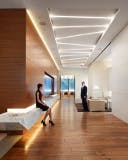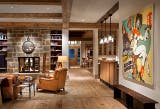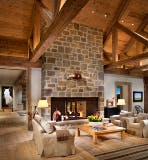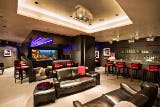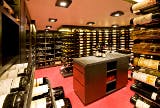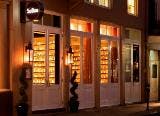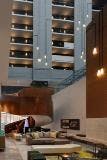This article was published in the Summer 2013 issue of IIF Magazine.
View the Table of Contents and download the PDF file of the complete Summer 2013 issue, or view the E-zine version in your browser.
+++++
Cooper Lighting has released the details of the lighting projects that were recognized in the 36th annual Source Awards that focus on lighting innovation in interior designs. Many of the projects recognized in 2013 include a common thread: Skilled designers can realize efficient and stunning lighting designs with legacy sources and relatively simple control schemes. The projects mixed light-source technologies to achieve results that were both functionally sound and experientially compelling.
The Source Awards were founded in 1977 and are open to projects that predominantly use Cooper Lighting products. Cooper appoints an independent panel of judges made up of lighting professionals along with a judge from the company's Source lighting education center. The judges evaluate the projects based on how well the lighting meets the design goals along with aesthetics, creativity, and technical performance — including energy efficiency. In fact, each entry must include a specification of the project power density.
The 2013 projects selected for recognition were initially identified at Lightfair International and include six professional awards, along with five presented to students for conceptual project descriptions and story boards (see table). In the professional category, actual projects are eligible to garner Winner, Honorable Mention, or Award of Recognition status in either residential or commercial categories.
Commercial winner
The Winner in the commercial category is the lighting of the Cole Capital office building in Phoenix, Arizona. Creative Designs in Lighting and the design team of Mark Mueller, Nikki Holt, and Walter Spitz were behind the project. In the entry, the team asked, "Who would have thought fluorescent lighting could be so much fun?"
Indeed, the project primarily utilizes linear fluorescent lighting and compact fluorescent downlights, along with halogen fixtures in select locations. The design team reported that the budget would not allow broad use of daylight harvesting. Still, the overall project power density is 0.88W/ft2. The controls are relatively straightforward with circuit-based controls zoned in open office areas, and room-based scene and dimming controls in meeting rooms and offices.
The reception area provides an excellent overview of the design philosophy (Fig. 1). The team called the look a "pick-up sticks" approach, referring to the patterned Cooper Neo-Ray fluorescent lighting recessed in the ceiling. Those fixtures utilize T5 tubes. To complement the ambient lighting, the team incorporated Cooper RSA Quiet Ceiling fixtures to accent art work on the walls. Those fixtures use HIR MR16 lamps that save as much as 43% in energy usage relative to legacy halogen sources.
The auditorium shows the attention the team paid to the architect's preferences (Fig. 2) — specifically, a request that no recessed downlights be used in the auditorium to preserve the customized louvered look of the ceiling. So the lighting team utilized Corelite Cove Solo Dimmable T5HO fixtures hidden in the louvers. The result is 30 fc at task level and soft lighting on the ceiling.
In a number of cases on the project, the design team enlisted the help of Cooper to make custom modifications to fixtures. For instance, the team utilized RSA Combolight fixtures to highlight art in the executive gallery, but the trimless fixtures required modification to be installed in the 2.25-inch-thick wood ceiling.
Residential winner
In the residential category, the winning project is the Colorow residence located in Edwards, Colorado. Robert Singer and Associates and the design team of Robert Singer and Kim Quint were responsible for the design. The home includes numerous custom pendants and chandeliers that were designed to match the western art and styling. But the design team creatively used Cooper IRiS downlights with halogen sources to deliver on the overall experience.
The residential design relies on a house-wide control system to set scenes and save energy. A path setting configures the downlights and recessed step lighting to a low level, allowing safe passage through the home with minimal energy usage. Groups of lights can be controlled for aesthetics and energy usage. Fig. 3 shows how halogen lights that highlight the artwork can be independently set at a higher level than the downlights placed to light the paths.
Other spaces include a mix of lighting types. In the great room, linear fluorescent fixtures hidden in the beams and trusses light the voluminous open ceiling areas (Fig. 4). P3MR-E3SA fixtures provide accent lighting on the fireplace and artwork. And P3MR-E3AA fixtures mounted near the ceiling peak light the table and seating area. In the kitchen and dining area, the design team combined P3MR fixtures for task and accent lighting along with the custom chandelier over the table, and LED lighting under cabinets in the kitchen.
Honorable mentions
Robert Singer and Associates were also responsible for the project that was awarded Honorable Mention recognition in the residential category. The design team of Robert Singer, Kim Quint, and Jason Diaz faced a unique challenge in lighting the Tiehack Compound in Aspen, Colorado. The owner built a pair of single-family homes on adjacent lots concurrently with similar architectures. And the lighting designers were tasked with implementing unique designs in each house yet still ensuring a cohesive look and feel that would allow the owner to live in either home and sell the other at some point.
Again, the design team relied heavily on IRiS P3MR downlights throughout the residences. The team added RSA Combo fixtures in some areas. For example, in the entry hall of one of the homes, the team used the combo fixtures in a dropped cove to highlight artwork in the hallway. And with both residences, the designers used Lumiè re fixtures to highlight exterior landscaping and stone columns outside the homes.
It was the entertainment areas, however, where the owners wanted large spaces with lighting that accentuated both the architecture and comfort of the spaces. One example is found in the home theater area of one of the homes (Fig. 5). The space includes a dedicated theater area along with a bar and lounge area. The theater itself features color-changing LED lighting mounted in the double-dropped ceiling cove. The team also installed linear LED fixtures under the bar rails and stairs to provide path lighting. The P3MR downlights provide the ambient lighting.
The wine cellar (Fig. 6) in one of the residences also demonstrated an innovative approach to dealing with the overall architecture. There is an exercise room directly above the cellar, and the weight of equipment upstairs limited the applicability of recessed lighting in the cellar. But LEDs enable thin form factors, and the team used surface-mount fixtures on the ceiling for ambient light. The designers added linear LED lighting mounted at the front of the millwork to light the bottles.
Moving back to the commercial category, the Jacobs Engineering Group received Honorable Mention recognition for a project at the University of North Texas Business Leadership Building in Denton, Texas. The design team of Kimberly Smith, Kevin Williams, and Nathan Carruth faced the challenge of helping Ennead Architects achieve the desired LEED Gold certification. Moreover, the designers were required to primarily rely on T8 fluorescent lamps due to the university's established standards for the inventory of lamps stocked and used on campus.
The design utilizes a number of Cooper fixtures that support T8 lamps including Neo-Ray, Portfolio, Metalux, Lumark, and Sure-Lite products. But it was the recessed and pendant Neo-Ray fixtures that were used most prominently in common areas, classrooms, and conference rooms.
In a large lecture hall at the university, 4-inch Neo-Ray suspended fixtures were run parallel with the wood-slat ceiling, providing a clean look. The design team said that the Neo-Ray fixtures allowed room to stagger T8 fluorescent lamps to both eliminate socket shadow and to deliver the required light levels at the task plane.
Awards of recognition
Cooper concluded the professional category this year with two Awards of Recognition. Reveal Design Group and designers Ken Ventry, Courtney Mark, and Levia Lew were recognized for a project at the SoBou restaurant in New Orleans, Louisiana. Tec Studio and designer Ardra Paige Zinkon won for a project at the Hilton Columbus Downtown in Columbus, Ohio.
Among the important elements of the SoBou design is the wall of bottles the team lit with LED strip lights, in which etched bottles ultimately appear to be the ambient light sources. That prominent feature within SoBou is also clearly visible from outside the restaurant where French Quarter regulations limited the amount of light used to call attention to the establishment (Fig. 7).
The Hilton hotel lighting used a broad variety of fixture types with LEDs playing a prominent role in retrofit lamps and custom-designed fixtures. In the lobby, for instance, skylights provide ambient lighting during the day and high-mounted Neo-Ray fixtures take over at night. But custom LED luminaires vertically drape the walls and columns for accent impact (Fig. 8). The team developed a custom fixture with a modular LED light engine that ensures the hotel will be able to service the luminaires if needed.
Cooper has already issued a call for entries for the 37th annual program. Entries are due by January 31, 2014. The organizers don't predetermine the number of projects recognized in the awards but rather let the quality of the entries dictate the awards presented.


